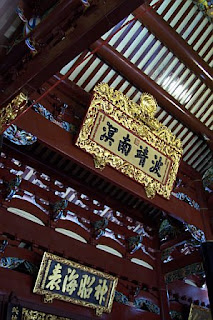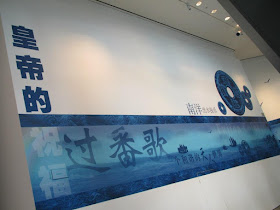 |
| Fujians: The Blue Ocean Legacy. |
I am not a Hokkien, i.e. I am not of direct Fujian descent. However, I was motivated to put this exhibition on the top of my must-see list of exhibition because of two main reasons:
1) A friend had attended this exhibition on 24 Nov 2012 and she strongly recommended it to me.
2) After a visit to The Maritime Experiential Museum, I became more intrigued with maritime travel such that it was very hard to resist heading for the exhibition Fujians: The Blue Ocean Legacy.
Photography and filming are strictly prohibited at this exhibition. Despite the challenge of limited visuals, I shall attempt to make it enticing enough for you to visit this exhibition before it ends on 28 Feb 2013.
 |
| At the ArtScience Museum. |
This exhibition showcases 600 pieces of exhibits, including rare artefacts which are classified as "First Class Cultural Relics" from Quanzhou city (in Fujian province, China). One of the highlights is a Yuan Dynasty Nestorian stone carvings of two Chinese fairies holding a Christian cross. This piece of stone carving is an example that reflected the dynamic cultural interactions that exist in Quanzhou, one of the greatest ports in the Far East, at that period in time.
 |
| This image looks like the Nestorian stone carvings that I had seen at Fujians: The Blue Ocean Legacy. Source: www.mq.edu.au |
The Min People
During my visit to this exhibition, I learnt that the Fujian culture is driven by a strong maritime history. Ancient Min people living in Fujian area have been recorded to venture beyond the ocean to explore new horizons.
I felt rather puzzled by the exodus of Hokkiens between 14th - 19th century and did not seem to find sufficient information on this at the exhibition. Nevertheless, it started getting me to relate to how my maternal grandparents and father had travelled across the seas from their hometown to live in Singapore. Maybe there could be a common thread that connects the Chinese in Singapore?
This exhibition also showcase a number of interesting maps. I love the idea of exhibiting the maps of Fujian against the map of China. I was intrigued by an old Fujian map published in the 27th year of the reign of Emperor Guangxu (1901). This map showed the administrative states of Fujian. Somehow, comparing this old map against today's map of Fujain made me gain a glimpse of how the Fujian province could have changed over time. I learnt that historical Fujian was known as the Minyue Kingdom.
Quanzhou the coin-casting centre in ancient time
From this exhibition, I learnt that Quanzhou was a coin-casting centre in ancient time. During the ancient times, each coin had to be cast from a single ceramic mould. To retrieve the completed coin, the craftsmen had to break the mould. Thankfully, it was easier to make coins during our times.
Artefacts of the Tang and Song dynasties
One of the sections of this exhibition focused on the artefacts of the Tang and Song dynasties. I learnt that during the Song dynasty (AD 960 - 1279), Fujian, along with Szechuan and Zhejiang, was one of the three main printing centres in China. The books that were printed in Jianyang, Fujian, were called "the books of Jian". In those days, people considered the books to be as valuable as gold.
The vessels from Fujian
The section of Fu Vessels fascinated me. Fu Vessels refer to the vessels from Fujian. These were considered to be one of the most advanced seafaring structures of their time. Fu Vessels have distinctive V-shaped bottoms, watertight bulkheads and moveable shafts. Since photography was not allowed, I took some time to do quick sketches of a few of the Fu vessles. The concatenate combat boat from the Ming dynasty (AD 1368 - 1644) had caught my interest. This offshore naval combat ship could be separated into two parts when needed and the part that held the dynamites could be left to attack an identified enemy.
The vessels from Fujian
The section of Fu Vessels fascinated me. Fu Vessels refer to the vessels from Fujian. These were considered to be one of the most advanced seafaring structures of their time. Fu Vessels have distinctive V-shaped bottoms, watertight bulkheads and moveable shafts. Since photography was not allowed, I took some time to do quick sketches of a few of the Fu vessles. The concatenate combat boat from the Ming dynasty (AD 1368 - 1644) had caught my interest. This offshore naval combat ship could be separated into two parts when needed and the part that held the dynamites could be left to attack an identified enemy.
 |
| A few sketches and some notes. |
Cultural interactions in Quanzhou
People who are interested in cultural interactions may find this exhibition to be interesting. In this exhibition, visitors learn about how various cultures interact with one another particularly in Quanzhou city, in Fujian province.
There was a sub-section on Lin Moniang who is commonly referred to as Mazu. She is said to be born on the island of Meizhou in Putian. The Mazu faith was said to have originated in Fujian during the early Northern Song dynasty about a thousand years ago.
Perhaps I had watched a few of those martial art television programmes based on novels by novelist, Louis Cha, it was difficult not to spend some time learning about Manichaeism, the "Religion of Light". I learnt that Fujian's Cao'an temple is the last remaining Manichean heritage site in the world.
Porcelain Road
This exhibition acquainted me with the concept of the Porcelain Road. Trading via land travel favoured light objects like silk. On the other hand, the maritime trade has made it more feasible to trade fragile and large items such as porcelain and ceramics. Thus, the maritime routes for the trading of porcelain was also referred to as the Porcelain Road.
Visitors would be treated to various ceramic wares such as the white porcelain, the celadon, the blue-and-white porcelain, the famille porcelain and more at this section of the exhibition. Please make time to admire a Ming Dynasty porcelain dish with peony and phoenix designs. Blue-and-white porcelain are celebrated for its beauty.
 |
| An example of porcelain. Taken at the Maritime Experiential Museum. |
Maritime finance
The section on maritime finance shed some light on how early overseas Chinese remitted money back to their hometown. I learnt that there is an interesting financial phenomenon of Overseas Chinese Remittance that existed in the 19th and 20th centuries. Money was sent along with letters to families back in one's hometown. The family members were entitled to send a return letter after receiving the letter.
Thian Hock Kheng Temple
There is a featured local artefact in this exhibition. It is the 1828 land title deed with the signature of Hokkien merchant and philanthropist Tan Tock Seng. This piece of land brought from the British East India Company was used to build the Thian Hock Keng Temple.
I was also attracted to the original imperial calligraphic scroll that was bestowed to Thian Hock Keng by Emperor Guangxu in honour of the contributions of overseas Hokkien. The scroll reads "gentle waves over the Southern Seas" in Chinese. If you wonder what the blessings on the scroll meant, please visit the exhibition.
Conclusion
This exhibition is rather interesting. If you have an interest in the Fujian culture, the maritime trade in the Far East and perhaps the Thian Hock Kheng Temple, I will strongly recommend that you visit this exhibition before it ends on 28 Feb 2013.
Please consider attending one of the guided tours. It is complimentary for ticket holders of the exhibition. English tours to this exhibition are available on Saturdays at 11.30 a.m. and on Sundays at 5.30 p.m. Mandarin tours are available on Saturdays and Sundays at 3 p.m. and 6 p.m.
If not, please consider renting one of the interactive digital guides from the ArtScience Museum Box Office at $6. I would recommend that visitors set aside about two to three hours for this exhibition.
Fujians: The Blue Ocean Legacy
24 Nov 2012 - 28 Feb 2013
ArtScience Museum, Marina Bay Sands Singapore
For more information, please visit: http://www.marinabaysands.com/Singapore-Museum/Whats-On/
Nearest MRT stations: Bayfront, Promenade.
Please also read:
I was also attracted to the original imperial calligraphic scroll that was bestowed to Thian Hock Keng by Emperor Guangxu in honour of the contributions of overseas Hokkien. The scroll reads "gentle waves over the Southern Seas" in Chinese. If you wonder what the blessings on the scroll meant, please visit the exhibition.
 |
| Inside Thian Hock Keng. A plaque inscribed with words presented by Emperor Guangxu. |
Conclusion
This exhibition is rather interesting. If you have an interest in the Fujian culture, the maritime trade in the Far East and perhaps the Thian Hock Kheng Temple, I will strongly recommend that you visit this exhibition before it ends on 28 Feb 2013.
Please consider attending one of the guided tours. It is complimentary for ticket holders of the exhibition. English tours to this exhibition are available on Saturdays at 11.30 a.m. and on Sundays at 5.30 p.m. Mandarin tours are available on Saturdays and Sundays at 3 p.m. and 6 p.m.
If not, please consider renting one of the interactive digital guides from the ArtScience Museum Box Office at $6. I would recommend that visitors set aside about two to three hours for this exhibition.
Fujians: The Blue Ocean Legacy
24 Nov 2012 - 28 Feb 2013
ArtScience Museum, Marina Bay Sands Singapore
For more information, please visit: http://www.marinabaysands.com/Singapore-Museum/Whats-On/
Nearest MRT stations: Bayfront, Promenade.
Please also read:



No comments:
Post a Comment